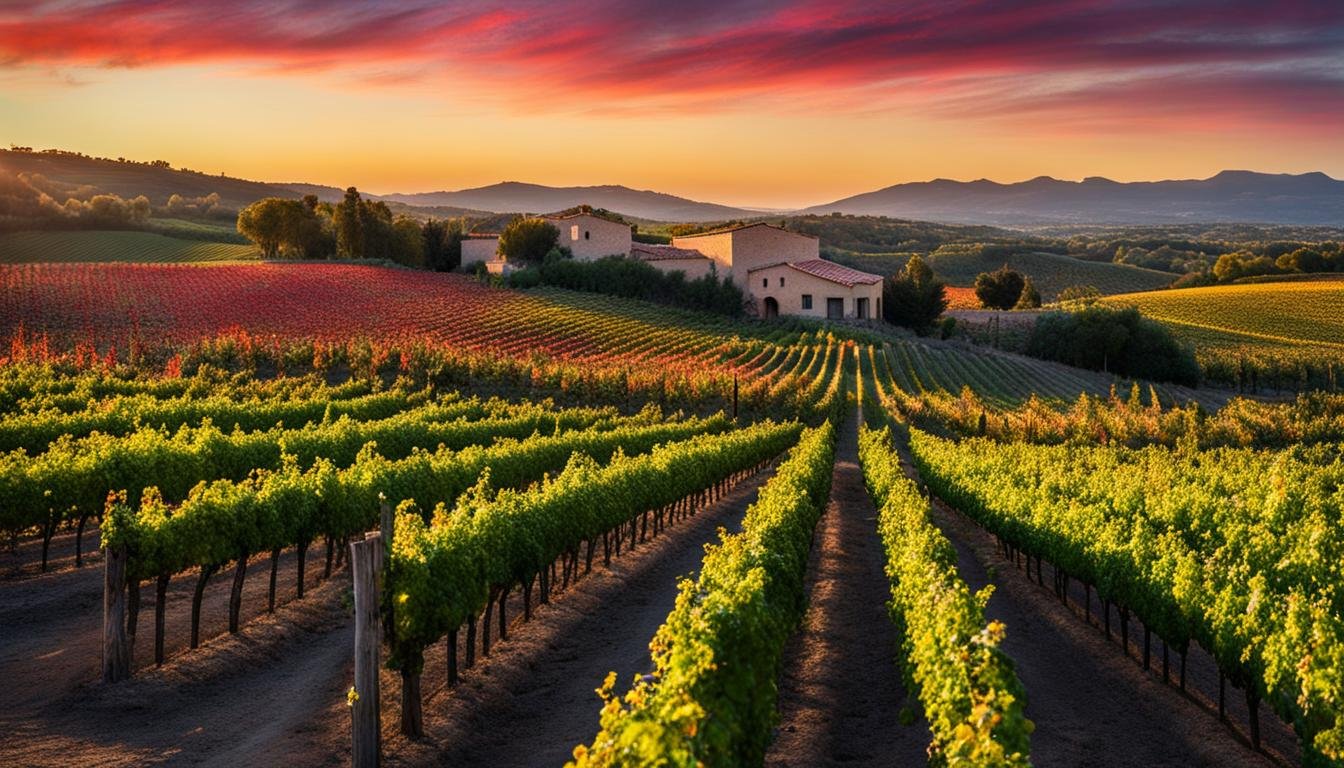This post may contain affiliate links. Please read my disclosure policy.
Grenache: The Genial Maverick of the Vineyard
Introduction to Grenache
Grenache (pronounced “gruh-NASH”) is like the wine world’s version of a best supporting actor – often in the background but undeniably essential. This red grape variety might not grab the headlines like Cabernet or Pinot Noir, but it’s a key player in some of the most beloved wines. From the sun-drenched hills of Spain (where it’s known as Garnacha) to the ancient vineyards of the Rhône Valley, Grenache is the backbone of many blends, bringing warmth, flavour, and character to the table.
Primary Flavours of Grenache
Sampling Grenache is akin to diving into a vibrant fruit basket. It’s brimming with ripe red berries, think strawberries and raspberries, with a twist of cinnamon and a whisper of white pepper for good measure. In warmer climes, it adopts a bolder persona, flirting with notes of black cherries and a sultry hint of chocolate. Grenache doesn’t just hint at flavours; it flaunts them with a confident swagger.
Taste Profile
| Grenache | ||
|---|---|---|
| Aspect | Rating out of 5 | Characteristic |
| Sweetness | 🍷 | Predominantly dry, with a hint of sun-ripened berries |
| Body | 🍷🍷🍷🍷 | Full-bodied, as warm and inviting as a Mediterranean beach |
| Tannins | 🍷🍷🍷 | Medium, like a soft but memorable handshake |
| Acidity | 🍷🍷🍷 | Balanced, adding a refreshing twist to its warmth |
| Alcohol by Volume | 🍷🍷🍷🍷 | Typically around 14-15%, as spirited as a Spanish fiesta |
| Each wine glass icon 🍷 represents one point on a 5-point scale. Grenache is known for its lush, fruity flavors, often with hints of cinnamon and black pepper. It's a key component in many blends, including those from the Rhône region and in Spanish wines. Grenache offers a delightful combination of fruitiness and spice, making it popular among a wide range of wine enthusiasts. | Each wine glass icon 🍷 represents one point on a 5-point scale. Grenache is known for its lush, fruity flavors, often with hints of cinnamon and black pepper. It's a key component in many blends, including those from the Rhône region and in Spanish wines. Grenache offers a delightful combination of fruitiness and spice, making it popular among a wide range of wine enthusiasts. | Each wine glass icon 🍷 represents one point on a 5-point scale. Grenache is known for its lush, fruity flavors, often with hints of cinnamon and black pepper. It's a key component in many blends, including those from the Rhône region and in Spanish wines. Grenache offers a delightful combination of fruitiness and spice, making it popular among a wide range of wine enthusiasts. |
Growing Regions
Grenache adores the spotlight of the sun, thriving in regions that bask in its warmth. From the historic landscapes of Spain (where it’s known as Garnacha) to the iconic vineyards of Southern France, and across the seas to Australia, it’s a globe-trotting variety.
Each region imprints its unique signature on Grenache, reflecting the terroir in every glass. In the Rhône Valley, it’s the star of the show in the renowned Châteauneuf-du-Pape blends, offering depth and complexity. Down Under in Australia, particularly in regions like Barossa Valley, it expresses a more robust and fruit-forward character, showing off the sunnier side of its personality.
Origin and Versatile Nature
The story of Grenache is a rich tapestry woven through the annals of viticulture. Believed to have originated in Spain, this grape quickly found a second home in the Rhône Valley, becoming a cornerstone of the region’s winemaking legacy.
Over the centuries, Grenache has been the quiet achiever, content to let its more famous offspring, like Syrah and Mourvèdre, take the limelight while it adds the crucial finishing touches. This journey from Spanish vineyards to global acclaim is a testament to Grenache’s versatility and enduring appeal.
Ideal Serving Temperatures
Serving Grenache at the ideal temperature is akin to finding the perfect pitch in music – it’s essential for harmony. Around 15-18°C (59-64°F) is the sweet spot, where its full bouquet of aromas and rich flavours can elegantly unfold.
This temperature allows Grenache to express its ripe fruit profile and subtle spice nuances without amplifying the alcohol. It’s like setting the stage for a seasoned performer – the right conditions make every act shine.
Glassware
The right glass for Grenache is like the perfect acoustic in a concert hall – it enhances the performance. A glass with a broad bowl, tapering slightly at the top, is ideal. This shape allows the wine’s aromas to collect and intensify, creating an aromatic crescendo before reaching your nose.
It also ensures that the wine is elegantly delivered to the palate, allowing the nuances of fruit, spice, and terroir to harmonise in every sip. In the world of wine glasses, this is the equivalent of a grand auditorium for Grenache’s solo performance.
Considerations for Decanting
Decanting Grenache can be as effective as a well-timed intermission – it enhances the experience. For more mature or complex bottles, a stint in the decanter allows the wine to breathe, softening the tannins and letting the layers of flavour develop and mingle.
However, younger, more fruit-driven styles are like a catchy pop tune – best enjoyed fresh and vibrant. Decanting isn’t a one-size-fits-all; it’s about accentuating the wine’s character and letting its personality shine through.
Insights into Ageing
Grenache’s potential for ageing is like a well-kept secret among wine enthusiasts. While its youthful expressions are delightful with their burst of fresh fruit, ageing can reveal a more sophisticated side. With time,
Grenache develops intriguing notes of leather, tobacco, and spice, adding layers of complexity to its fruity core. This transformation is like watching a character evolve in a gripping novel, each chapter revealing new depth and intrigue.
Complementary Food Pairings
Grenache is as versatile with food as a multi-instrumentalist is with genres. Its medium body and smooth tannins make it an excellent match for a range of dishes. Think grilled meats, hearty stews, or a spicy tagine – Grenache can handle them all with aplomb.
For vegetarians, aubergine dishes, lentil curries, or a hearty mushroom pie can be sublime pairings, complementing the wine’s fruit-forwardness and spice. Whether it’s a casual meal or a fine dining experience, Grenache has the flexibility to adapt and enhance the culinary ensemble.
Renowned Wine Labels
| Grenache | Grenache | Grenache |
|---|---|---|
| Country | Wine Label | Varietal Name & Style |
| France | Château Rayas | Elegant, Ethereal Châteauneuf-du-Pape |
| Spain | Bodegas Alto Moncayo | Bold, Spicy Garnacha |
| Australia | Torbreck | Lush, Robust Barossa Grenache |
| USA | Tablas Creek | Refined, Californian Rhône-style |
| South Africa | Sadie Family Wines | Innovative, Complex Swartland |
| These wineries showcase Grenache in all its glory, from the traditional, nuanced styles of the Old World to the bold, fruit-forward expressions of the New World. Each producer brings a unique touch to this versatile grape, highlighting its potential to produce wines of exceptional quality and character. | These wineries showcase Grenache in all its glory, from the traditional, nuanced styles of the Old World to the bold, fruit-forward expressions of the New World. Each producer brings a unique touch to this versatile grape, highlighting its potential to produce wines of exceptional quality and character. | These wineries showcase Grenache in all its glory, from the traditional, nuanced styles of the Old World to the bold, fruit-forward expressions of the New World. Each producer brings a unique touch to this versatile grape, highlighting its potential to produce wines of exceptional quality and character. |
The Grenache Persona
In the grand tapestry of wine varieties, Grenache is the affable maverick – friendly, approachable, yet with a depth that surprises. It’s a grape that doesn’t take itself too seriously but commands respect for its adaptability and complexity. It’s the wine for every occasion, ready to elevate a meal or to be savoured on its own.
Conclusion
Grenache is more than just a wine; it’s a celebration of versatility and joie de vivre. It’s about embracing the bold and the beautiful, the fruity and the spicy, all wrapped in a package of approachable elegance. So, when you next open a bottle of Grenache, be prepared for a journey that’s as lively and genial as an old friend’s embrace. It’s the wine that promises – and delivers – a delightful experience in every glass.
FAQ
Is Grenache known by any other names?
Grenache is known as Garnacha in Spain and as Cannonau in Sardinia, Italy. These different names reflect its cultivation in various Mediterranean wine regions.
What are some interesting facts about Grenache?
• Grenache is one of the most widely planted red grape varieties in the world.
• Originating from Spain, it’s a key grape in both Spanish and French wines.
• Known for its berry flavours, spicy notes, and soft tannins.
• Often used in blends, notably in Châteauneuf-du-Pape and Priorat.
Is Grenache a red or white wine?
Grenache is primarily a red wine grape, used to make rich, flavourful red wines. There is also a white variant, Grenache Blanc, used for white wines.
To which wines is Grenache similar?
Grenache is similar to Syrah and Mourvèdre, with which it is often blended (GSM blends). These grapes share a profile of ripe fruit flavours and are often used together in Rhône-style wines.
Is Grenache known by any other names?
Grenache is known as Garnacha in Spain and as Cannonau in Sardinia, Italy. These different names reflect its cultivation in various Mediterranean wine regions.
User Review
( votes)Sip smarter, subscribe now!
Subscribe for gourmet tips, event updates, travel ideas, and a free e-book on Food Pairings. Start your journey to culinary and travel excellence!













